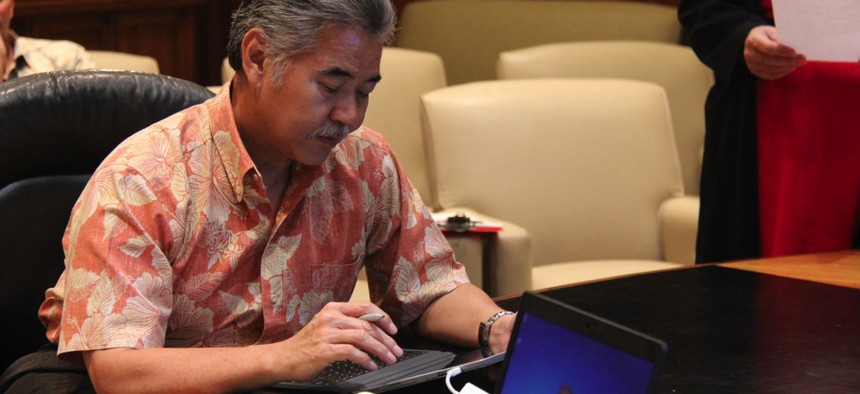A Year Into Hawaii’s Push to Go Paperless

Hawaii Gov. David Ige e-signing a document. Hawaii Governor's Office
Government agencies scattered across seven islands make delivering services to residents a challenge that electronic signatures help alleviate.
State employees have electronically signed more than 64,000 documents since Hawaii’s state government began digitizing all its forms more than a year ago.
Paperless government is a game-changer in a state with such unique geography—agencies spread across eight main islands—in terms of sustainably providing services to 1.4 million citizens.
Using Adobe Sign , data within documents flows directly into databases, removing human error from the equation and saving time and money.
“Documents executed electronically create this really clean archive,” said Dan Puterbaugh, legal director and associate general counsel for Adobe Design, in an interview. “Hawaii is very much an innovator, more out in front than other states have been.”
While 48 states have adopted the Uniform Electronic Transactions Act , Hawaii Gov. David Ige has driven its usage from the top—proclaiming Oct. 10 Electronic Records Day in the state and e-signing said proclamation.
Cost savings are only beginning to sink in some states, Puterbaugh said, but Hawaii estimates as many as 25,000 government employees use Adobe Sign.
Chief Information Officer Todd Nacapuy’s first two hours in state government were spent signing human resources documentation by hand, which he found “ridiculous”. Now HR forms are sent to new employees before they start.
Enterprise Technology Services prints 41,000 pages a day but will halve that in the next two months getting employees to sign documents on their mobile devices.
“It’s really about giving our public servants the tools that they need to do their job,” Ige says in this Adobe video. “And I’m convinced that giving them the latest digital tools allows them to be even more efficient and effective than they would normally be.”
In addition to going green, e-signatures have the added benefit of bolstering privacy through the cloud.
Citizens dealing with state government often provide sensitive, personally identifiable information on forms. Handwritten signatures are easy to fake, but electronic documents are sent to specific email addresses, often with additional security measures like a unique smartphone code in place, to validate identities and avoid fraud.
Audit trails are important for legal compliance, and good software programs detail the lifecycle of a signature from the time a document is created and sent to the time of signing—establishing a strong evidentiary record you don’t get with paper.
“We are cautious by nature, and that is one of the things that has occasionally slowed the process,” Puterbaugh said.
Dave Nyczepir is a News Editor at Government Executive’s Route Fifty and is based in Washington D.C.
NEXT STORY: An Ongoing Mystery in Minnesota: Who Jammed the State’s Health Insurance Hotline With Calls?






